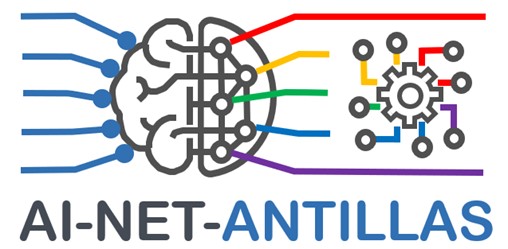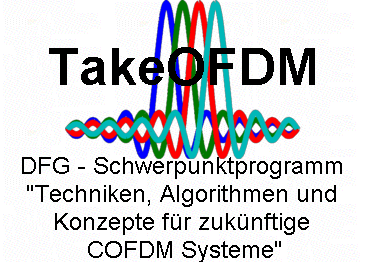AI-NET-ANTILLAS
Project Description
At a time when information and communication technology are converging more than ever, intelligent network automation is an imperative to increase the scalability, security and reliability of communication networks. It is also the enabler for new digital services and applications, many of which we cannot even imagine today. Especially in times of limited mobility, it becomes clear that automation is indispensable to guarantee network operation, optimize resource consumption and flexibly configure services.
The aim of the project at KIT's CEL is to develop new algorithmic and technical methods for optical data transmission on the physical layer. Special emphasis is put on the use of AI-based methods in order to significantly improve the communication quality and implementation of conventional methods with special consideration of non-functional properties such as flexibility, reconfigurability and energy consumption, latency and throughput.
The focus of the project at CEL lies in particular on algorithm development, taking into account constraints that arise in various practical implementations, and the creation of evaluation and simulation tools for the optimization of flexible, high-performance transmitters and receivers. Special attention is given to flexible and fast adapting methods, which form the transmission basis for future flexible networks and ensure the adaptivity of these very networks. These novel transmission methods are evaluated and demonstrated in cooperation with the partners.
Selected Results
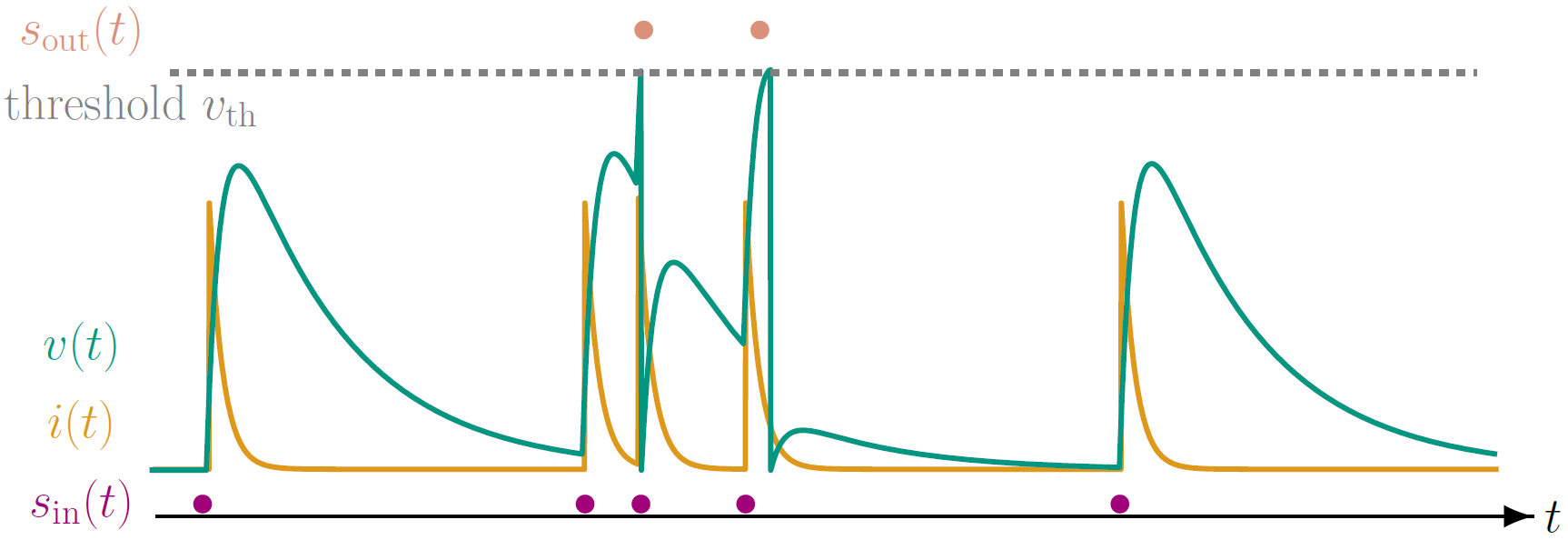

Funding
This project is carried out in the framework of the CELTIC-NEXT project AI-NET-ANTILLAS (C2019/3-3) and receives funding from the German Federal Ministry of Education and Research (BMBF) under grant agreement 16KIS1316.
Links
Low-Power ELT-SDR
Project Description
Since the Malaysia-Airlines MH370 incident, research in novel “Search & Rescue” (SAR) techniques has been intensified in the aviation industry. The result of this effort is the planned introduction of the novel class of Distress Tracking Emergency Locator Transmitters (ELT-DT). Additionally, a novel standard is introduced by COSPAS-SARSAT, which uses a digital Direct Sequence Spread Spectrum (DSSS) technique instead of a narrowband modulation.
This and future changes lead to the exchange of old emergency locator transmitters, in order to fully exploit the advantages of the new system. This entails however a larger investment. The KIT would like to research, develop and deliver a generic software-defined radio (SDR) platform to the project partner Becker Avionics. This platform serves as later basis for different ELT classes, which can be efficiently and rapidly adapted to current and future SAR standards to improve the survival chance in case of an incident. An open and flexible communication interface shall enable the integration into existing overall systems.
Additionally, KIT will carry out research on novel technologies that will further improve survival rates. Besides a reduction of the power consumption by improving the algorithms, enabling a longer transmit duration before the battery is completely used, KIT will investigate the use of the ELT as Cognitive Radio (CR). With a CR, emergency calls can be transmitted on additionally frequencies, e.g. via maritime distress radio in case of incidents over the ocean. Additionally, the possibility of an extra digital in-band data transmission within the current emergency frequencies (not impairing existing systems) will be investigated. In this case, besides audio and speech packets of short duration, data of sensors (e.g., of future life vests) can be transmitted to the approaching rescue teams. These will be able to adapt to the needs of the victims of the incident and increase their chances of being rescued.
Funding
This work receives funding from the German Federal Ministry for Economic Affairs and Climate Action (BMWK) under grant agreement 20Q1964B.
CREDIT
Cooperative Receive-Diversity in Wireless Networks: A Stochastic Geometry Approach
In cooperative diversity spatially distributed nodes share resources to form a virtual multi-antenna array. This concept enhances communication performance and has become a core technology in wireless networks. Networks also show a trend toward heterogeneity and opportunistic deployment with only limited site planning, thereby rendering the interference quasi-random and making it the performance-limiting factor. Since research on cooperative diversity has not been able to keep pace, there are still several open questions in such fundamentally-changing networks.
In the project StoCCNets, funded within the DFG priority program COIN, some of these questions have been addressed using tools from Stochastic Geometry. This approach resulted in a plurality of insights that are of particular relevance for this follow-up proposal:
- Tx vs. Rx diversity: In Selection Decode-and-Forward, cooperating antennas should be placed closer to the destination as a consequence of the vulnerability to interference. Also, Tx diversity may not be very effective.
- Diversity Order: The reliability gain of cooperative diversity is not increased by processing only the information, i.e., by applying “conventional” relaying.
- Diversity Loss: Interference correlation renders the channel states of the links statistically dependent, thereby lowering achievable diversity. However, the analysis also shows that cooperative strategies should process both information and interference, thereby exploiting interference correlation as additional channel state information to achieve Rx diversity.
The follow-up project CREDIT investigates various aspects of interference-aware cooperative diversity in a unifying way. Existing approaches such as receiver conferencing and interference forwarding shall be revised and their behavior in the presence of random interference shall be studied.
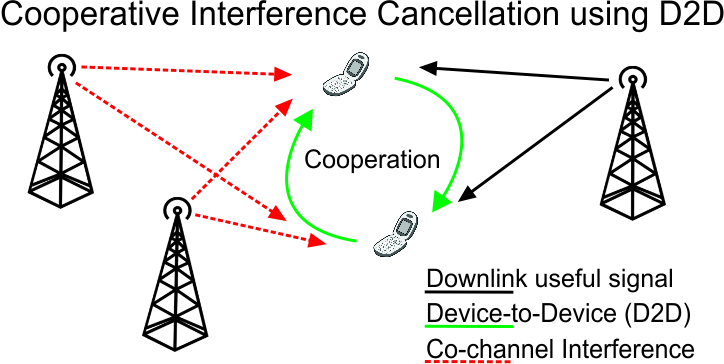
In particular, the suitability of interference rejection methods shall be analyzed. While variations of this problem have been already treated from an information-theoretic perspective, properly modeling and quantification of spatial interference correlation will be addressed by using powerful tools from Stochastic Geometry, finally assessing interference rejection techniques in the cooperative scenarios considered in this project.
Furthermore, the theoretical approach shall be complemented by studying implementation issues in order to identify key system parameters and to guarantee feasibility of the proposed cooperative ideas, increasing the scientific impact of our contributions.
Especially the D2D interface, proposed in 3GPP Rel-12, is of great interest. Important aspects of D2D shall be investigated in order to develop appropriate cooperation techniques enabling upcoming architectures.
Suboptimal and low-complexity algorithms that realize the cooperative receive diversity approach shall be investigated. Besides, in order to complete the system perspective, suitable protocol structures will be studied.
StoCCNets
Stochastic Geometry for the Analysis of Coordination and Cooperation in interference-limited ad hoc Networks
Recently, interference-limited ad hoc networks gained growing interest in the wireless network community. It turns out that the spatial configuration of nodes in the network and the medium access strategy are of primary concern, since they are determining the interference situation in the network. This is because, in contrast to interference in time and frequency, interference leakage in space cannot be engineered. Thus, the actual spatial configuration significantly influences network performance.
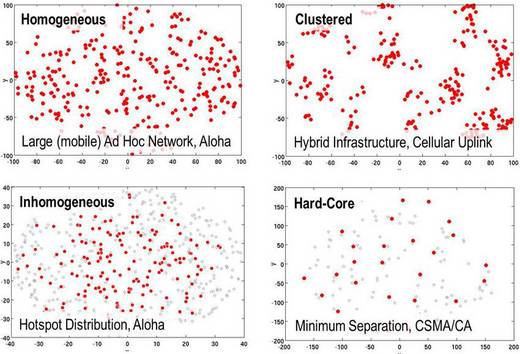
This fact resulted in the emergence of the research framework called “Stochastic geometry for wireless ad hoc networks”. Here, spatial processes are used to model the random locations of nodes. By this, the degree of freedom coming from the unknown spatial configuration is replaced by the choice of an appropriate spatial model. Currently, results in this research field are mainly assuming a simplified network model, in which medium access is uncoordinated and transmissions are non-cooperative.

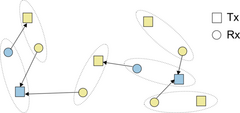
The project StoCCNets aims at extending this research field by studying coordination of medium access to avoid excessive interference and cooperative communications in order to increase coverage and throughput in interference-limited ad hoc networks. In this project, it is mandatory to model and to analyze the effects of coordination and cooperation in interference-limited networks by means of stochastic geometry, in order to enable optimization and ubiquitous benchmarking of coordination and cooperation strategies.
RadCom
Entwurf und Evaluierung von Systemkonzepten zur gemeinsamen Realisierung von Radarsensorik und Funkkommunikation auf Basis von OFDM
Im Kontext intelligenter Verkehrssysteme und Methoden zur Erhöhung der Verkehrssicherheit sind zwei Technologien von besonderer Bedeutung: Fahrzeug-Fahrzeug Kommunikation, mit dessen Hilfe sich Fahrzeuge untereinander über Verkehrssituationen oder Fahrmanöver austauschen können, und Radarsysteme, die dem Fahrzeug Informationen über die Umgebung einschließlich des restlichen Verkehrs bereitstellen können.
Das Projekt RadCom untersucht die mögliche Fusion der beiden Systeme. Ziel ist es, eine gemeinsame Hardware und ein gemeinsames Signal für die Radarsensorik und die Kommunikation zu verwenden. Dies spart Hardware und Frequenzen, ermöglicht aber auch die Ausnutzung von Synergieeffekten. Die Resultate sollen, wo möglich, auf generelle mobile Ad Hoc-Netzwerke erweiterbar sein.
RadCom läuft im Rahmen des DFG-Schwerpunktprogramms "TakeOFDM" und wird in Kooperation mit dem Institut für Hochfrequenztechnik und Elektronik (IHE) erforscht.
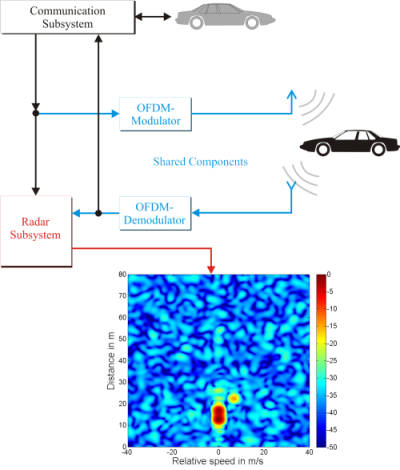
MIRA
MIRA wurde im Rahmen des DFG-Schwerpunktprogramms Ultrabreitband-Funktechniken für Kommunikation, Lokalisierung und Sensorik (UKoLoS) gefördert.
Ultrabreitbandige Funksysteme (Ultra-Wideband, UWB) nutzen prinzipiell den gesamten Frequenzbereich von einigen 100 MHz bis über 10 GHz. Damit werden sowohl die absolute als auch die relative Bandbreite extrem groß. Die große absolute Bandbreite erlaubt eine sehr hohe Orts- bzw. Zeitauflösung für Sensor- und Positionierungsanwendungen, ohne daß Mehrdeutigkeiten auftreten. In der Kommunikationstechnik können entweder extrem große Datenraten über kurze Entfernungen oder niedrige Datenraten energieeffizient über größere Entfernungen übertragen werden. Die sehr niedrige spektrale Leistungsdichte eines UWB-Signals und der große Korrelationsgewinn sind die Voraussetzung für die Koexistenz mit herkömmlichen, schmalbandigen Systemen. Der Koexistenzproblematik kommt dabei eine viel größere Bedeutung zu als bei herkömmlichen Funksystemen. Mit den im UWB-Spektrum enthaltenen niedrigen Frequenzen ist eine Eindringung in bzw. eine Durchdringung von Objekten möglich. Mit UWB-Sensoren können gegenüber schmalbandigen Verfahren viel mehr Information über die Materialeigenschaften und die Struktur des durchdrungenen bzw. reflektierenden Mediums gewonnen werden.
Angesichts der extremen Bandbreite stellt die UWB-Technik völlig neue Anforderungen. Das betrifft die nachrichten- und hochfrequenztechnischen Systemkonzepte, die Signalverarbeitung, die Parameterschätzung, die physikalische Interpretation der Messergebnisse sowie den schaltungs- und hochfrequenztechnischen Entwurf der Komponenten. Generell bedeutet die UWB-Technik einen Paradigmenwechsel von Schmalband- zu Breitbandverfahren.
Im Rahmen von MIRA wird eine pulsbasierte Architektur mit einem nicht-kohärenten Empfänger als ein geeigneter Kandidat zur Realisierung eines kostengünstigen und einfachen UWB-Systems untersucht. Indem der Grundaufbau zu einem Mehrkanalsystem erweitert wird, können bemerkenswerte Datenraten im Bereich von mehreren hundert Mbit/s bis nahezu einem Gbit/s erreicht werden. Eine solche physikalische Schicht ermöglicht kostengünstige energieeffiziente Sender (z.B. Sensoren) für sehr niedrige Datenraten, aber auch energieeffiziente Sender/Empfänger für extrem hohe Datenraten. Da Störungen das Hauptproblem bei nicht-kohärenten UWB-Geräten darstellen, liegt der Fokus dieses Projekts auf der Definition einer PHY-Schicht und einer Sender/Empfänger-Architektur unter Beachtung eines optimierten Verhaltens in Gegenwart von Störungen. Das vorrangige Ziel dieses Projekts ist die theoretische Analyse der physikalischen Schicht einer Multiband Impulse-Radio-Architektur.
TAKOKO
Techniken, Algorithmen und Konzepte für COFDM Systeme zur Koexistenz mit autorisierten Systemen im selben Frequenzband
Download: Technischer Bericht 1,Technischer Bericht 2, Jahresbericht 1, Jahresbericht 2
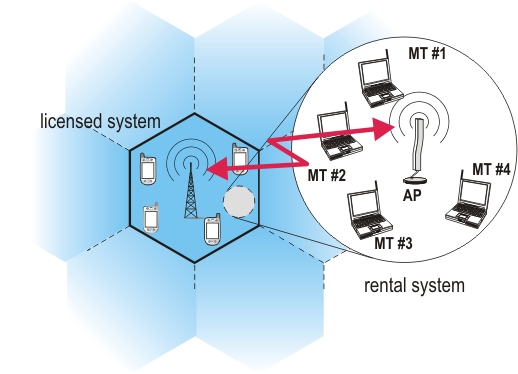 Koexistenz eines Mietsystems im Frequenzband eines Stammsystems |
Die stark eingeschränkte Verfügbarkeit der Ressource Frequenz für Zwecke der drahtlosen Informationsübertragung zwingt zu einer Effizienzsteigerung bei der Nutzung des elektromagnetischen Spektrums. Daher werden in letzter Zeit vermehrt Überlegungen angestellt, in geeigneten Frequenzbändern eine Nutzung durch koexistierende Systeme zuzulassen. Eine Koexistenzstrategie ist z.B. die „Ultra Wide Band“ (UWB) Übertragung, die bereits von der amerikanischen „Federal Communications Commisson“ (FCC) zugelassen wurde. Eine weitere Koexistenzstrategie ist der Einsatz von GPRS („General Packet Radio Service“) in GSM („Global System for Mobile Communications“) Systemen. Einen allgemeinen Ansatz bietet das „Spectrum Pooling“, das die gemeinsame Nutzung eines Frequenzbandes durch die hierfür autorisierten Teilnehmer (Stammnutzer) eines Stammsystems durch sogenannte Mietnutzer eines Mietsystems gestattet. | |
| Das Projekt TAKOKO (Techniken, Algorithmen und Konzepte für COFDM Systeme zur Koexistenz mit autorisierten Systemen im selben Frequenzband) baut auf den Untersuchungen zum "Spectrum Pooling" auf und untersucht eine Koexistenzstrategie, die sich explizit die Flexibilität des COFDM Verfahrens bezüglich der Spektralbelegung zunutze macht. Zur Steigerung der Spektrumseffizienz wird der Einsatz von COFDM basierten Systemen als Mietsysteme im Frequenzband eines autorisierten Stammsystems untersucht. |
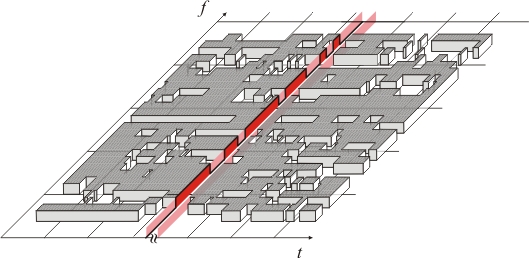 ineffiziente Spektralbelegung | |
 OFDM Träger, Überlagerung des Stammsystems durch ein Mietsystem |
|
| TAKOKO ist ein gemeinsames Projekt des Instituts für Kommunikation und Navigation (DLR) und des Instituts für Nachrichtentechnik (Universität Karlsruhe) und wird im Rahmen des Schwerpunktprogramms Techniken, Algorithmen und Konzepte für zukünftige COFDM Systeme (TakeOFDM) von der DFG gefördert. |  |
OOS
OFDM-basierte Overlay-Systeme zur dynamischen und effizienten Nutzung des Spektrums
Die stark eingeschränkte Verfügbarkeit der Ressource Frequenz für Zwecke der drahtlosen Informationsübertragung zwingt zu einer Effizienzsteigerung bei der Nutzung des elektro-magnetischen Spektrums, die beispielsweise durch die Koexistenz mehrer Systeme im selben Frequenzband realisiert werden kann. Neben "Ultra Wide Band" (UWB) oder "General Packet Radio Service" (GPRS) für GSM ("Global System for Mobile Communications") bieten so genannte Overlay-Systeme einen Ansatz, die einem Füllsystem die Übertragung in Belegungslücken im Frequenzband des autorisierten Hauptsystems gestatten.
In diesem Forschungsvorhaben wird ein Overlay-System basierend auf OFDM untersucht, das seine Übertragung durch einfaches An- und Abschalten einzelner Unterträger flexibel an die wechselnde Spektrumsbelegung anpasst. Ziel des Forschungsvorhaben ist es, die physikalische und MAC-Schicht eines OFDM-basierten Overlay-Systems so auszulegen, dass eine dynamische Anpassung an eine variable Belegungssituation des Spektrums möglich ist, die zur Verfügung stehenden Ressourcen möglichst effizient genutzt werden und gleichzeitig sicher gestellt ist, dass die autorisierten Hauptsysteme nicht durch das Füllsystem beeinträchtigt werden.
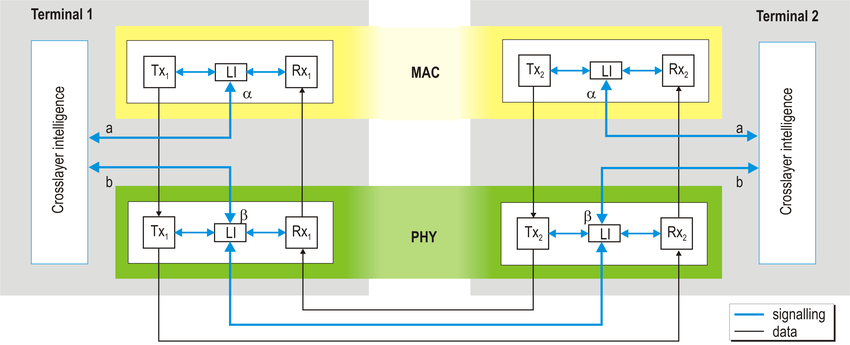
Crosslayer-Framework für Overlay-Systeme: Austausch von Daten und Signalisierungsinformation zwischen PHY und MAC Schicht
| OOS ist ein gemeinsames Projekt des Instituts für Kommunikation und Navigation (DLR) und des Instituts für Nachrichtentechnik (Universität Karlsruhe). |
 |
E2R
The End-to-End Reconfigurability (E2R) research, aims at bringing the full benefits of the valuable diversity within the Radio Eco-Space, composed of a wide range of systems such as cellular, wireless local area and broadcast. The key objective of the E2R project is to devise, develop and trial architectural design of reconfigurable devices and supporting system functions to offer an expanded set of operational choices to the users, applications and service providers, operators, regulators in the context of heterogeneous mobile radio systems. Innovative research, development and proof of concept should be sought over six years in an end-to-end aspect, stretching from user device all the way up to Internet protocol, and services, and in reconfigurability support, intrinsic functionalities such as management and control, download support, spectrum management, regulatory framework and business models.
Pulsers
Key deficiencies in today's wireless technologies hindering immediate realisation of the IST vision "Optimally Connected Anywhere, Anytime" are limited spectral resources, missing functional features, high power consumption and cost. Luckily, an alternate but somewhat disruptive wireless technology capable to leapfrog this unsatisfactory state of "Pervasive Computing and Communication" is about to emerge: ultra-wideband radio technology (UWB-RT).
PULSERS - an industry led initiative built on the enthusiastic response and selection of 30 key industrial and academic organisations - will explore, develop and exploit the large technological and application potential of UWB-RT and contribute towards consensus building processes on coexistence and standardisation issues. The project's strategic, scientific and technological objectives are defined to strengthen Europe's knowledge base and readiness to successfully exploit the benefits of UWB-RT.
Based on typical and novel application scenarios, PULSERS will develop advanced systems and usage concepts and deliver innovative enabling physical layer and medium access technologies. The project embraces two complementary application scenarios by judiciously trading achievable data rate versus range and using UWB-RT's unique capability to fuse communication and positioning:
- larger range systems with lower data rates combined with localisation and tracking (LDR-LT);
- systems offering high and very high data rates (HDR/VHDR) over shorter range. In the HDR space, data rates of well beyond the state-of-the-art is an ultimate target while localisation accuracies below 30 cm are aimed for in the LDR-LT space.
Through leveraging of investments and results from related projects in IST/FP5 and by assembling a critical mass of key European and international researchers and engineers, PULSERS is well poised to achieve a lasting scientific and technological impact towards the beneficial use of UWB-RT by all.
PULSERS was an R&D project embedding verification procedure on real platforms.


